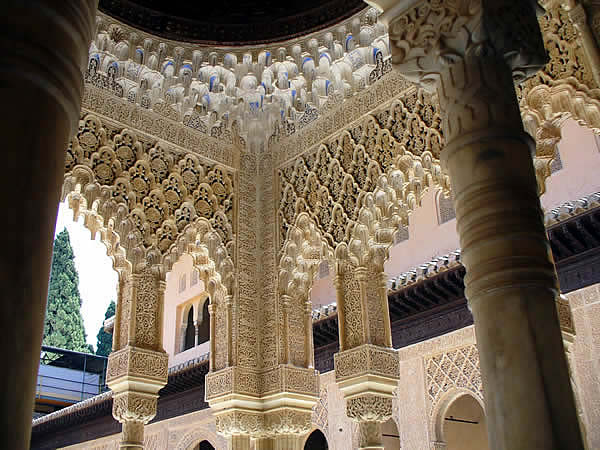This post is also available in:
![]() Deutsch
Deutsch ![]() Português
Português ![]() Español
Español
Granada is a beautiful city in Andalusia in southern Spain. The city with about 240,000 inhabitants is located almost 700 meters high at the foot of the Sierra Nevada mountains at the confluence of the Genil and Darro rivers. The city extends partly flat and partly over the Alhambra and Albaicin hills.
The area of Granada was formerly inhabited by the Iberians, when the Romans colonized the south of Spain and founded the city of Iliberis. In the eighth century the Arabs who occupied the Iberian peninsula gave the city its current name. Starting in 1031, Granada was the capital of an autonomous emirate and the most important center of Moorish Spain. This city was also the last Arab stronghold to surrender to the Catholic reconquista in 1492.
Important architectural testimonies of the past Arab domination remain. The most important are undoubtedly the Alhambra or royal citadel, the Generalife (country residence) and the Moorish quarter of Albaicín.
In 1984 the Alhambra, the Generalife and the Albaicín district were declared World Heritage Sites by UNESCO. High above the modern city, the Alhambra and the Albaicin, located on two adjacent hills, form the medieval part of Granada. To the east of the Alhambra fortress are the magnificent Generalife gardens, the ancient country residence of the emirs who ruled this part of Spain in the 13th and 14th centuries. The residential district of Albaicin is very characteristic and is full of Moorish-style buildings.
WHAT TO SEE: THE MAIN ATTRACTIONS OF GRANADA
THE ALHAMBRA
The Alhambra, the medieval Arab royal citadel that dominates the city, is universally recognized as one of the jewels of world architecture, it is composed of a series of palaces and gardens built in the 14th century during the Nasrid dynasty.
The name Alhambra derives from the red color (al-Hamra) of the thirteenth-century walls of the oldest fortress (Alcazaba). In the following decades, the wonderful buildings of the Emir’s palace, the palaces and towers of the Alcazar were added. The visit of this immense complex has its strengths in the Sala de los Embajadores, in the Patio de los Leones and in the Sala de las Dos Hermanas.
After the Christian conquest the Alhambra complex was used as a prison. Then in 1526 Charles V destined it to his residence, demolished part of it by building the Palacio de Carlos V. This palace is an example of Spanish Renaissance architecture, where today the Museo de Arte Hispano-Musulman and the Museo de Bellas Artes are housed (Spanish paintings).
THE GENERALIFE
The Generalife, the fourteenth-century country residence of the emirs is located just below the walls of the Alcazar. Here there are beautiful gardens, some hanging, fountains and you can admire beautiful views of the Sierra Nevada and the city. Also noteworthy are the hydraulic works that allowed the irrigation of the gardens.
THE GOTHIC CATHEDRAL AND THE OTHER CHURCHES
In the city there are other valuable monuments, including the huge Gothic Cathedral built, in place of the Mezquita Mayor, between 1523 and 1703. Here are the Capilla Mayor work by Diego de Siloe and the Gothic Capilla Real where are the tombs of Isabella and Ferdinando carved by the Tuscan Domenico Fancelli. Among the churches, in addition to the Cathedral, the churches of Santa Ana (in Mudejar style, 1537-1563), San Salvador (in Mudejar style, 16th century), Santo Domingo (1532), San José and San Jeronimo (1496- 1547).

THE OLD ARAB MEDINA: ALBAICIN
On the hill facing the Alhambra is the Albaicin, the old Arab casbah or “medina”, a fascinating maze of narrow streets and alleys lined with white houses with small internal gardens. At the highest point of the hill is the Plaza de San Nicolas from where you have a wonderful view over the citadel of the Alhambra.
Despite the fact that many Arab palaces were destroyed after the reconquista, Granada still houses the most complete group of houses and palaces with Arab architecture in Europe. In fact, buildings such as Dar al Horra, or Alcazar Genil, or houses such as the Horno de Oro house, the Chapiz house, or the Abén Humeya house, are only the most famous. Public baths such as El Bañuelo or the Alhambra baths, and the complex of Arab public fountains and wells (aljibes), are unique in Europe.
To the north of the city is the Sacromonte hill, famous for its gypsy dwellings carved out of caves. Just outside the city, on a hill, is the Cartuja Monastery, with a sumptuous Baroque interior.
HOW TO GET TO GRANADA: FLIGHTS
Air flights: Granada airport is the Federico García Lorca Granada-Jaén Airport (IATA: GRX). This airport is located near the towns of Chauchina and Santa Fe, 15km west of Granada. Granada can be reached via Vueling flights that stop in Barcelona or Iberia flights that stop in Madrid.
The climate of Granada.
